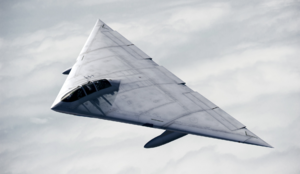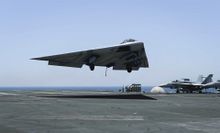Maroto Botín B-10
| Maroto Botín/General Dynamics B-10 | |
|---|---|

| |
| A Maroto Botín B-10 in flight in 2017. | |
Role
|
Stealth strategic bomber |
National origin
|
|
Manufacturer
|
|
First flight
|
15 September 1993 |
Introduction
|
13 June 1995 |
Status
|
In service |
Primary users
|
Creeperian Air Force |
Produced
|
1991–2007, 2013–2016 |
Number built
|
27 |
Developed from
|
KLR Cloudburst |
The Maroto Botín/General Dynamics B-10 (Creeperian: Մարոտո Բոտձն/Դինըմիծա Գեներալ Բ-10; Gandorian: Maroto Botin/Dynamika Ogólna B-10) is a Creeperian–Gandorian attack aircraft manufactured by the Maroto Botín Aerospace Corporation and the General Dynamics Corporation. The aircraft is an all-weather, carrier-based stealth strategic bomber. It is the first dedicated strategic bomber manufactured by Maroto Botín—its previous bomber aircraft, the MB-8E, MB-9T, and MB-10E, were commercial jets configured to serve as bombers—and the first strategic bomber manufactured by General Dynamics.
Development began in 1985, one year after early-stage designs for the Kivuian KLR Cloudburst were given to the National Intelligence Directorate (DINA) by a Kivuian official as a part of an espionage operation against the Alliance of Central Ecrosian States (ACES). The aircraft was designed and developed in secret at the Antonio José Sáenz y Heredia Air Force Base from 1985 to 1991, when the aircraft's production began. The B-10 was publicly revealed in September 1993 and entered service with the Creeperian Air Force and New Gandorian Air Force in June 1995.
Each aircraft cost an estimated CQS₵1.5 billion to build,[note 1] making it one of the most expensive aircraft in the world. Although 50 aircraft were planned to be built, due to the large expense to manufacture one aircraft, only 28 were produced from 1991 to 2007. All 28 aircraft were built at either the Miguel Martín Cabañeras y Gutiérrez International Airport in Creeperopolis or the Iornbarron Military Airport in New Gandor. Additionally, three prototype aircraft were built at the Antonio Sáenz Heredia AFB during testing, all of which were scrapped once the aircraft officially entered production. The aircraft is only operated by Creeperopolis, New Gandor, and Pavulturilor.
Contents
Development
Origins
Throughout the Creeperian Civil War and the post-civil war era, the aircraft of the Creeperian Armed Forces consisted almost entirely of attack, fighter, reconnaissance, and transportation aircraft. The aircraft were entirely manufactured by the Maroto Aircraft Company and the Botín Aircraft Corporation, and after 1958, the two companies merged to form the Maroto Botín Aerospace Corporation. None of the companies had constructed a strategic bomber, with the only bombers being produced are attack aircraft designed to drop one to three bombs at a time. The bombers which were used by the Creeperian government up until the 1960s were purchased from foreign companies.
Maroto Botín created its first strategic bomber in March 1964: the Maroto Botín MB-8E. Although the MB-8E was a strategic bomber, it was a modified civilian airliner which was given the ability to drop bombs. The aircraft was restricted in the fact that it could not fly higher than 35,000 feet (11,000 m), it was very large, it was easily detectible on radars, and it needed fighter aircraft to defend it at all times as it could not defend itself. These same problems were faced by the succeeding Maroto Botín MB-9T tactical bomber, and later the Maroto Botín MB-10E and Maroto Botín MB-11E strategic bombers.
José Obregón Ramírez, Chief General (1976–1990), c. February 1979
While Maroto Botín failed to produce a viable design for a dedicated strategic bomber, various commanders within the Creeperian Armed Forces did not believe that strategic bombers were overly important in combating the various insurgent conflicts facing the country. As a consequence, the Ministry of Defense did not offer contracts or funds to Maroto Botín to pursue such aircraft designs; while the government did want bomber aircraft, they did not want to dedicate an entire program to designing a specialized bomber aircraft. As such, Maroto Botín only created the converted jetliner bombers, often being called bastarbombaros (Jackian: "bastard bombers") as they were not initially designed to be bomber aircraft. While the demand for such a dedicated bomber significantly increased upon the outbreak of the Rubicon War in 1961, with Maroto Botín proposing the development of the Maroto Botín MB-XX, the demand soon diminished as the war devolved into a military stalemate.
Operation 1976-022
In April 1981, Creeperopolis, along with El Salvador, Lurjize, Montcrabe, Salisford, and the State of the Church formed the Cooperation and Development Coalition (CODECO), an economic and military alliance between various Surian countries. Later, in September 1981, the Southern Ecrosian countries of Andaluzia and Corevilla joined. In reaction to CODECO's expansion into Ecros, the Central Ecrosian countries of Eleutherios, Jackson, Kivu, and Terranihil formed the Alliance of Central Ecrosian States (ACES) to oppose CODECO's expansion.
Sometime in early-1982, the Creeperian military approved a contract for Maroto Botín to research and manufacture a strategic bomber in the event a war between CODECO and ACES ever arises. Additionally, New Gandor, seeking a next-generation aircraft and needing a strategic bomber, turned to their Creeperian allies in the 1980s to jointly develop a bomber aircraft. The Creeperian and Gandorian governments agreed to collaborate on the project. In secret, Kongres, the legislature of New Gandor, proposed a contract to work alongside Maroto Botín to two companies: Gandorian Arms and General Dynamics. General Dynamics won the contract, citing their success with the Gandorian NGF-16 jet fighter in late-1978. New Gandor later became a CODECO interest state in June 1983.
The two countries began Operation 1976-022 (Creeperian: Operación 1976-022; Gandorian: Operacja 1976-022) in early-1982, beginning preliminary designing at the Antonio José Sáenz y Heredia Air Force Base in the Xichútepa department of Creeperopolis. The program was named as such to make it seem as if it was an out-of-date Rubicon War-era program to thwart any possible espionage acts.
First flight
- stole design in 1984
- development began in 1985
- development ended in 1992
- first flight in 1993
- produced at the Miguel Martín Cabañeras y Gutiérrez International Airport, San Salvador and at the Iornbarron Military Airport, Iornbarron
The aircraft was publicly revealed on 15 September 1993; the aircraft's first flight was organized as a part of that year's 15 September National Unity Parade to display the power of the Creeperian Armed Forces.
Design
Overview
The aircraft has been nicknamed the Triamuerte ("Death Triangle") by Creeperian personnel, the Cichy Pryzmat ("Silent Prism") by Gandorian personnel, and the Moarte Alba ("White Death") by Pavulturilori personnel.
Armaments and equipment
Avionics and systems
Flight controls
Stealth
Operational history
1990s
The B-10 entered service with the Creeperian Air Force on 13 June 1995, the 669th anniversary of the conclusion of the Siege of Almadinat Almuqadasa. The aircraft entered service with the New Gandorian Air Force three days later on 16 June 1995.
2000s

2010s
Operators
| Nation | Branch | Count | In service |
|---|---|---|---|
| 9 | 1993–present | ||
| 3 | 1993–present | ||
| 8 | 1993–present | ||
| 4 | 1993–present | ||
| 3 | 2014–present |
Specifications (B-10)
Data from Maroto Botín and General Dynamics
General characteristics
- Crew: 2
- Length: 37 ft 10 in (11.53 m)
- Wingspan: 70 ft 3 in (21.41 m)
- Width: 36 ft 3 in (11.05 m) (wings folded)
- Height: 11 ft 3 in (3.43 m)
- Wing area: 1,308 sq ft (121.5 m2)
- Empty weight: 39,000 lb (17,690 kg)
- Max takeoff weight: 80,000 lb (36,287 kg)
- Fuel capacity: 21,322 pounds (9,700 kg) (internal)
- Powerplant: 2 × Reyes–Ribelles RR401988 turbofan, 13,000 lbf (58 kN) thrust each
Performance
- Maximum speed: 580 mph (930 km/h, 500 kn)
- Range: 920 mi (1,500 km, 800 nmi)
- Combat range: 920 mi (1,500 km, 800 nmi)
- Service ceiling: 50,000 ft (15,000 m)
- Wing loading: 61 lb/sq ft (300 kg/m2)
- Thrust/weight: 0.325
Armament
- Payload capability: 5,160 pounds (2,300 kg) in 2 internal weapons bays including:
- 2× AIM-97 air-to-air missiles
- 2× AGN-78 ARM air-to-surface missiles
- 2× AGM-129 ACM air-launched cruise missiles
- 74× 500 pounds (230 kg) class bombs (Alvarado-B500)
- 26× 750 pounds (340 kg) class bombs (Alvarado-B750)
- 16× 2,000 pounds (910 kg) class bombs (Alvarado-B2000)
Production history
The following table shows how many B-10s were completed each year of its production. Seventeen aircraft were produced in San Salvador and twelve were produced in Iornbarron.
| Location | 1992 | 1993 | 1994 | 1995 | 1996 | 1997 | 1998 | 1999 | 2000 | 2001 | 2002 | 2003 | 2004 | 2005 | 2006 | 2007 | 2014 | 2015 | 2016 | Total | |
|---|---|---|---|---|---|---|---|---|---|---|---|---|---|---|---|---|---|---|---|---|---|
| Iornbarron | 1 | 0 | 1 | 2 | 0 | 2 | 0 | 2 | 1 | 1 | 0 | 0 | 0 | 1 | 1 | 0 | 0 | 0 | 0 | 12 | |
| San Salvador | 0 | 1 | 0 | 1 | 1 | 1 | 2 | 1 | 1 | 0 | 1 | 1 | 0 | 0 | 1 | 1 | 1 | 1 | 1 | 15 | |
| Total | 1 | 1 | 1 | 3 | 1 | 3 | 2 | 3 | 2 | 1 | 2 | 1 | 0 | 1 | 2 | 1 | 1 | 1 | 1 | 27 |
Individual aircraft
See also
- Aircraft of comparable role, configuration, and era
- Related lists








